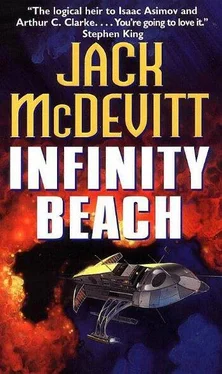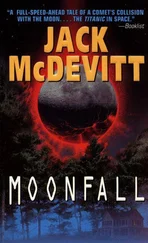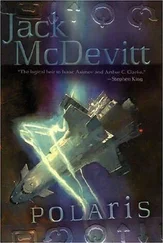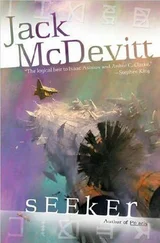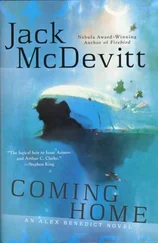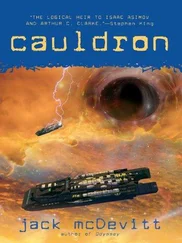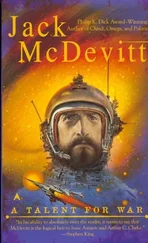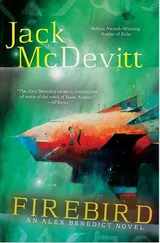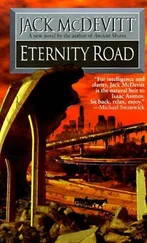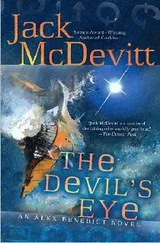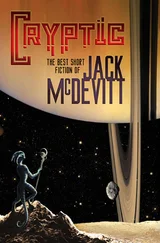He thought about it, looked at the stairway, pushed at the rail and watched the structure sway. Then he pointed his light down into the room below. It looked harmless enough, with a long table, a couple of chairs, and several trash bags stacked against a wall.
“I think we ought to just pass,” he said.
“Only take a minute.” She went down, testing each step, and was glad to get off at the bottom. The basement was less cold and damp than the rest of the house.
There were three rooms and a bath. She found a broken sofa decaying in one, and some carpets stacked up in another.
The table had data feeds, housings, and connections for electronic equipment. A mount hung from the ceiling. Probably for a VR unit.
“See anything?” asked Solly. The beam from his lamp illuminated the stairway.
“It was a workroom or lab at one time. I’ll be up in a minute.”
The walls were cedar-paneled, and they’d held up fairly well. The floor was artificial brick. There were magnets where pictures or plaques had once hung.
“Well,” she said, “ that’s interesting.”
“What is?” called Solly.
The stairway started to swing. “Don’t try to come down,” she said. “It’s a trash can.” With the imprint EIV 4471886. She checked her notes: It was Hunter’s designator.
It was half-filled with metal parts and crumpled paper and rags. There were expended cartridges of compressed air and cleaning fluid canisters and an empty wine bottle. She found food wrappers and packing for computer disks and reams of printed pages.
They consisted of lists of names, possibly donors for the Foundation; financial statements; purchase records; test results for various engine configurations; and all kinds of other data whose purpose she couldn’t make out. But all had dates, and the most recent she could find was January 8,573. Before Tripley had left on the last Hunter voyage.
Several of the trash bags had been ripped open, probably by animals. She turned them over one by one and spilled their contents, finding corroded cables and hardened towels and dust cloths and battered monitor housings and interfaces and juice cartons.
Someone more thorough than she was might have been willing to take the time to go methodically through the trash. Who knew what might be there? But it was getting colder. And it seemed pointless.
The wind moved through the house like something alive. There were noises in the walls and tree limbs brushed windows upstairs. She turned the beam around the room, watching the darkness retreat and close in again.
“I don’t think there’s anything here,” she told Solly. “I’ll be up in a minute.” She hoisted herself onto the table, took off her shoes and socks, and rubbed her feet, which had lost all feeling. When she got the circulation going she turned the socks inside out. It didn’t help much because they were stiff and cold, but it was something.
When she was finished she dropped back onto the floor. Amid the debris, she saw a woman’s shoe. It was impossible to know what color it had originally been, but it had a curious kind of fibrous sole, unlike any she’d seen before.
What was it?
She put it into her utility bag.
“Kim.” Solly’s voice betrayed impatience. “Are we ready yet?”
“Coming up,” she said.
He provided light, angling his lamp so it wouldn’t be in her eyes, told her to be careful, and appeared to be holding his breath, waiting for the staircase to collapse. She was about halfway up when a support broke and the whole structure dropped a few centimeters. She grabbed for the rail. He leaned forward as if to come to her aid but instantly thought better of adding his weight to hers. In that moment her own lamp silhouetted him, and she saw something draw back into the darkness.
She froze, the swaying staircase forgotten.
“Take your time,” said Solly.
She was sure she had seen it.
A piece of the darkness that infested the house. A piece that had broken off and withdrawn.
When she got to the top she swung her beam around the kitchen, looked into the doorways, and stepped out into the middle of the rotunda to survey the upper level.
“What’s wrong?” asked Solly.
There were shadows everywhere. “Nothing,” she said.
He knew better, but he didn’t pursue the issue, other than to follow her eyes. “I don’t guess you found anything?”
She held out the shoe. “Ever see one like this?”
He played his light over it. “Sure,” he said. “It’s a grip shoe.”
“A what ?
“A grip shoe .” He took it from her and pushed it against a wall. It stuck momentarily, and then fell. “Well,” he said, “it’s kind of beat up, but they’re used on starships in zero-gravity situations.”
“—Used on starships.” She held it against her own foot. Too small. It couldn’t have been Emily’s.
“What are you thinking, Kim?”
“Just wondering who it belonged to.”
The wind had died down and some of the clouds had blown off. Out over the lake, one of the moons had broken through.
They retraced their steps back down the hill and into the trees. They found the place where they’d doubled back and turned away from the river. Their prints were still deep and clean and they followed them back toward the flyer, moving deliberately, driven by the knowledge that it would be warm and dry in the aircraft.
But suddenly the prints stopped. In the middle of the trail, they were there, and beyond a certain point, between one step and another, they were not .
“The wind must have covered them over,” said Solly.
They were quite clear here, his large prints, her small; and they were simply missing there . They turned on their lamps. Incredibly, it was as if the two of them, earlier in the evening, had simply materialized out of the air. Materialized with his left footprint, her right, behind which there was only virgin snow.
She looked behind them, playing her light against the trees and along the trail. Nothing moved. “Yes,” she said. “Must have been the wind.”
They hurried forward, expecting the tracks to show up again momentarily. The lamp beams bobbed in front of them. Neither spoke now, and Solly picked up Kim’s habit of looking behind at regular intervals.
“I remember this oak,” she said. “We came right past here. I know we did.” But the snow was deep and apparently undisturbed.
Eventually the path divided and they hesitated.
“Which way?” she asked.
“The lake’s on the left,” whispered Solly. “Stay close to the lake.” Solly seemed unsettled and that positively terrified her.
They got lost, as was inevitable under the circumstances. At one point Kim caught her jacket on a dog-rose bush and tore it.
They broke finally into the glade with the tumbled shed and the footprints began again. She should have been glad to see them, but they were simply there , appearing in the middle of the glade, nothing on this side of them except unbroken snow, as if their earlier selves had stepped off the world. The sight chilled her.
“Keep going,” said Solly.
That part of the mind which withdraws from fear and watches emotional eruptions with dispatch now suggested she was in a VR scenario, that what she was experiencing could not happen in the real world.
Or that Sheyel had been right.
They came out of the tree line and saw the lake and the flyer. Kim fought down an urge to run for it. They walked deliberately across the beach, moving with comic swiftness.
Behind them, the forest remained dark and quiet. Far off to the east, a string of lights moved against the sky. The train from Terminal Island bound for Eagle Point. Solly keyed the remote and the flyer’s lights came on. The hatch opened and the ladder dropped.
Читать дальше
